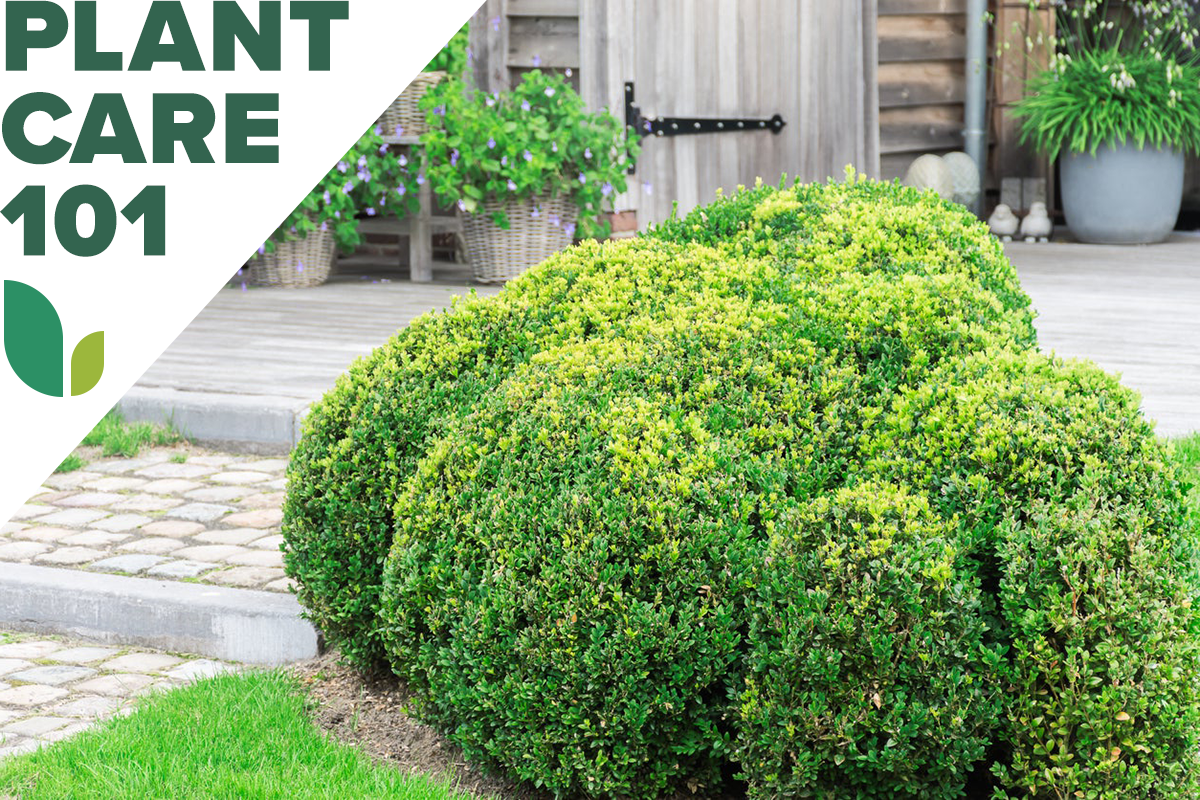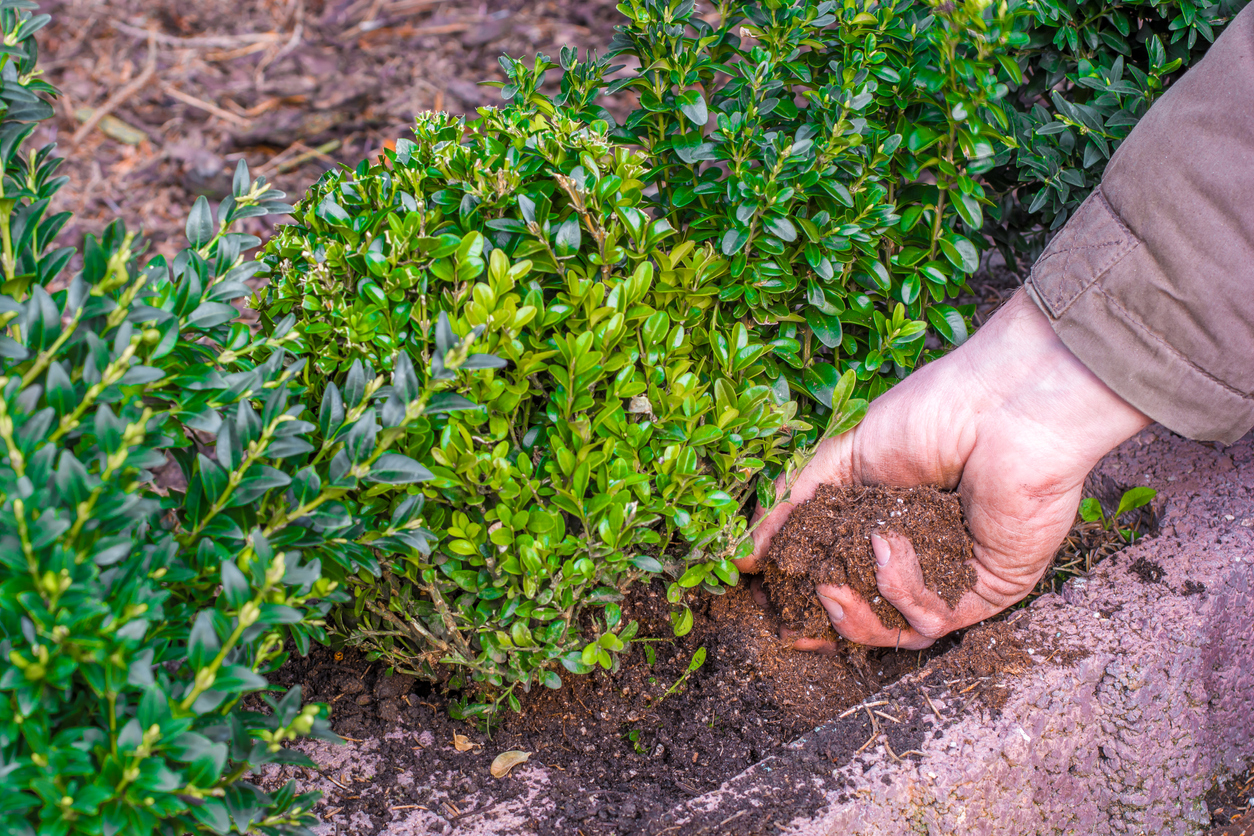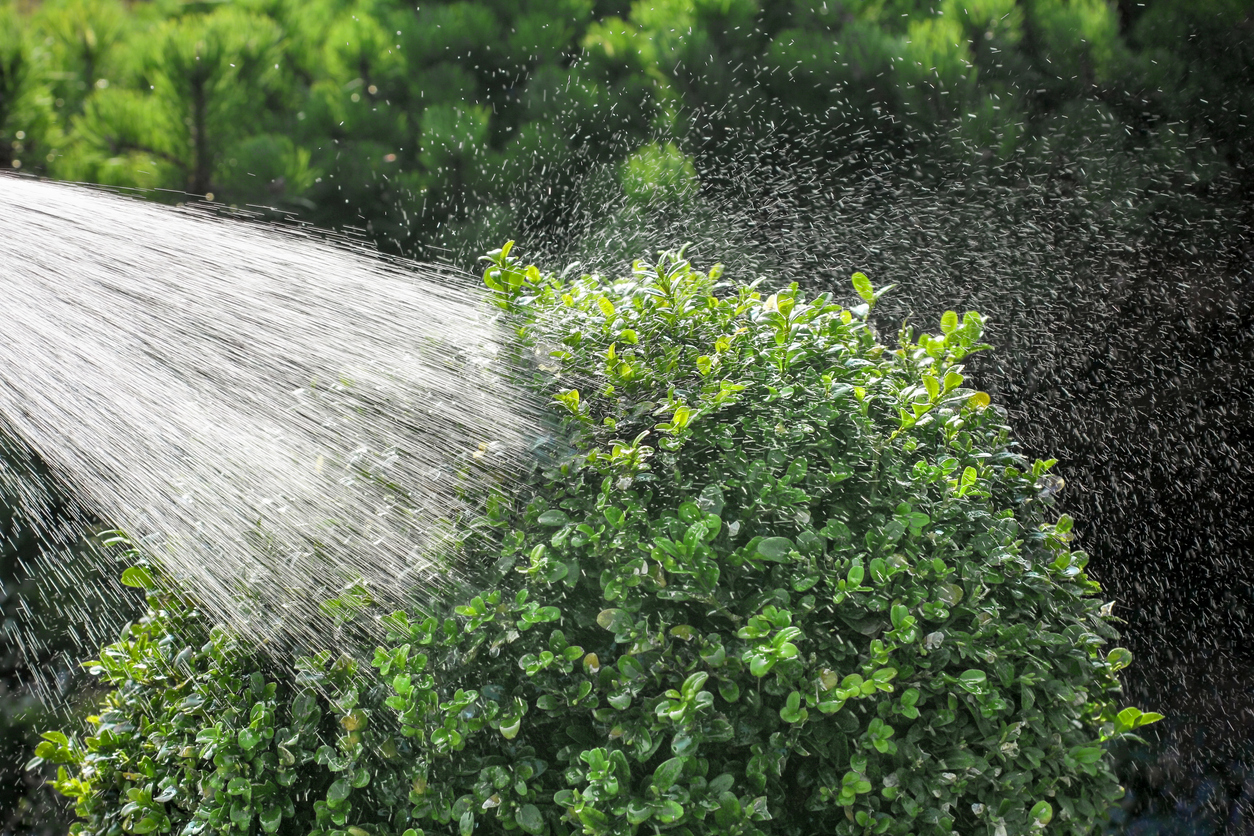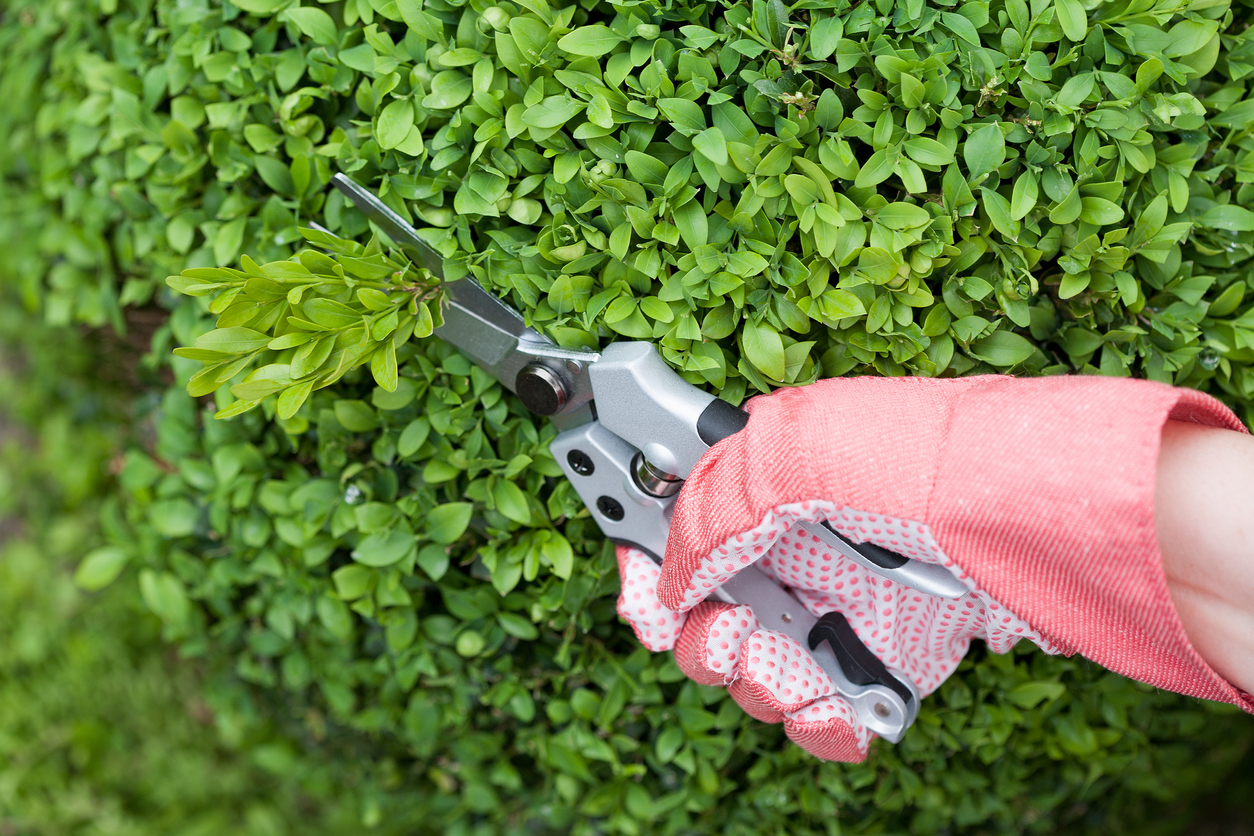

We may earn revenue from the products available on this page and participate in affiliate programs. Learn More ›
Boxwood shrubs are dense evergreens that don’t feel like typical evergreens. This slow-growing perennial features leathery, almost glossy green leaves that are small, rounded, and densely packed—which is one reason the boxwood hedge is so popular. Another reason is that this plant is easy to prune to almost any shape and desired size, so it’s a classic topiary choice.
The boxwood bush is prized for its functionality, versatility, and low maintenance, making boxwood care relatively simple. Above all, boxwood is an attractive, hardy shrub that can add privacy, formality, elegance, and year-round greenery to almost any landscape.
RELATED: How to Plant a Bush or Shrub
Growing Boxwood at a Glance
Common Name: Boxwood
Scientific Name: Buxus sempervirens
Hardiness Zone: Zones 5 through 9
Soil: Loamy; pH 6.5 to 7.0
Light: Full or partial; some varieties grow in full shade
Water: Weekly deep waterings initially; once or twice a month for mature plants
Food: All-purpose fertilizer in the spring
Propagation: Mid-summer stem cuttings
Safety: Potentially toxic to humans when eaten; toxic to dogs, cats, and horses
Boxwood Characteristics
Native to Europe (where they’re referred to simply as “box”), Asia, Africa, South and Central America, Mexico, and the Caribbean, the boxwood shrub is a stylish evergreen. Most grow 1 to 6 feet tall, although some types of boxwood shrubs can grow up to 20 feet high.
Hardy and disease-resistant, boxwood shrubs don’t require much maintenance other than regular pruning. However, they are slow-growing and dense, so those pruning demands aren’t intensive.
Buxus sempervirens grows in full sun to near-full shade. Most are a deep green, although there are variegated boxwood varieties. Boxwood’s leathery leaves are small, rounded, and densely packed, which makes them an exceptional choice for living fences, although some gardeners prune them into animal shapes or other topiary designs.
Recommended Boxwood Varieties
There are more than 200 varieties of boxwood. Here are a few popular types:
- American boxwood, also known as European boxwood, is an evergreen bush with small, round leaves that is not particularly resistant to cold and heat. This variety can grow 10 feet tall, making it a good choice for tall hedges or topiaries.
- English boxwood, or true dwarf boxwood, is easy to grow and features a rounded form and lush foliage. This dwarf variety of the American boxwood grows slowly until reaching 3 to 4 feet tall.
- ‘Green Pillow’ is a slow-growing, low-mounding dwarf boxwood variety that matures at just over a foot tall, with a 3-foot spread. It features tiny green leaves on branches that grow from a single trunk, forming a dense green dome.
- Korean boxwood, or Chinese boxwood, is more resistant to cold, staying green in temperatures of minus 20 or 25 degrees Fahrenheit.
- ‘Winter Gem’ is a variety of Korean boxwood that can grow in colder regions. Dense, slow-growing, and hardy, Winter Gem will grow 4 to 6 feet tall and wide, and it makes for a stunning formal garden border.
- Sprinter Boxwood offers Winter Gem parentage. Growing 2 to 4 feet tall, it is ideal for low hedges or borders. Hardier than English boxwood, Sprinter is a fast grower and disease-resistant—even to boxwood blight.
Planting Boxwoods

Boxwood care begins with attention to temperature and other conditions, as well as planting. With a few important steps in mind, like site selection and timing, a new boxwood can get off to a sturdy start.
When is the best time to plant boxwood?
The best time to plant boxwoods is spring, but late fall or late winter also can work in many regions. These planting times allow the plants to become established and get acclimated to their conditions before temperatures become too hot or too cold. Avoid planting boxwood when temperatures are at their most extreme. Heat and drought can stress newly planted shrubs.
Where can boxwood grow?
Each boxwood variety has different light needs, but in general, most need 5 to 6 hours of full sun per day, although some do well in partial or full shade. Uneven distribution of sunlight can cause some boxwood’s leaves to turn yellow, particularly in the larger varieties. Also important is selecting a spot with well-draining soil. Lastly, choose a location that offers protection from winter wind to prevent boxwood bronzing, a yellow-to-brown bronze-like coloration in leaves.
RELATED: How to Grow Butterfly Bush
How do you plant boxwood?
Get boxwoods off to a good start by planting them properly. For the best results, prepare them for planting and follow up with additional care after they’re in the ground. When planting boxwood, observe these crucial steps:
- Water the plant in its pot.
- Dig a hole as deep as the pot’s height.
- Separate the roots if they’re potbound.
- Place the plant in the hole and cover with soil.
- Add compost.
- Tamp down the soil around the plant.
- Water thoroughly.
- Add mulch.
Can you grow boxwood in containers?
Boxwoods hardy to your local climate can grow well in containers. Use pots at least twice as wide and tall as the plant’s root ball in order to give the roots space. The container and potting mix must provide good drainage, and a hole in the bottom of the pot is essential to allow excess water to drain.
Typically, smaller boxwoods do best in containers. Some gardeners prune them for a “boxwood tree” look. Place containers holding taller varieties in areas protected from wind to keep them from tipping over.
Shrubs in containers dry out faster than those in the ground, so a container-grown boxwood will need regular watering. Potted boxwood care in winter, however, may require reduced watering to prevent their roots from freezing.
Watering Boxwoods

For the first year or two after planting, boxwood shrubs should receive deep waterings weekly, as long as there is sufficient drainage. Boxwoods like moist soil, but they don’t like wet feet. If the soil is waterlogged, reduce the plant’s irrigation. Once a boxwood matures, it should only need watering during times of drought or extremely hot, dry weather. Early morning is the best time to water. Avoid watering the heat of the day, when water can evaporate faster, and in evening, when soil might not dry out enough overnight.
Fertilizing Boxwoods
Generally, boxwoods don’t need fertilizing when planted in good soil with a pH between 6.5 and 7.0. However, applying an all-purpose fertilizer in early spring promotes new growth. Select a slow-release, balanced fertilizer for this. Mixing compost mixed into the soil can also be beneficial.
Late-fall fertilization is also acceptable because boxwood roots grow most in late fall, winter, and early spring. Avoid fertilizing boxwood shrubs during the summer and early fall to prevent the onset of new growth toward the season’s end, as it will be susceptible to damage from frost or freeze.
Pruning Boxwoods

Boxwoods can be left alone to grow into an informal shape by trimming the longer branches only, but maintaining a desired shape and size requires pruning. Trimming boxwoods for maintenance also involves removing any dead or damaged branches.
It’s easy to create shapes—boxes or rectangular hedges, balls, and even topiary figures. As for when to trim boxwoods lightly or for shape, the best time is spring. Pruning boxwoods in the spring encourages new, healthy growth. For that reason, avoid pruning this shrub after August because doing so will stimulate growth that won’t have time to harden off before winter.
In extreme cases, rejuvenate boxwood by pruning back to within about 1 foot of ground level.
RELATED: The Dos and Don’ts of Pruning a Bush
Propagating Boxwoods
Boxwoods can be propagated by rooting stem cuttings taken in midsummer.
- Cut 3- to 4-inch-long stems from new growth.
- Strip the lower leaves and scrape the bark on one side of the cutting.
- Plant the cutting in a pot containing a mixture of sand, peat moss, and vermiculite.
- Moisten the soil and cover with a plastic bag.
- Set in a bright location.
- Mist if the cutting dries out.
- Once roots develop, transplant into a pot containing a rich potting mix.
- Set in a sunny location until planting time the next spring.
Safety Considerations
All parts of the boxwood plant are toxic—particularly the leaves and sap. Boxwood shrubs pose potential (but rare) toxicity hazards to people. Boxwood foliage is a mild skin irritant for a small number of people. Eating an excessive amount of boxwood foliage can cause dizziness, spasms, respiratory distress, nausea, vomiting, and diarrhea in people, but these reactions are also rare.
Boxwood can be toxic to dogs, cats, horses, and other animals if ingested in large quantities. However, some livestock species have been known to eat boxwood leaves, which can cause diarrhea, dehydration, excessive salivation, and in extreme cases, seizures or death.
Potential Pests and Diseases

Boxwood blight, a fungus, is perhaps the most common disease to strike this showy shrub. Brown spots with dark edges appear, sometimes with yellow halos. They usually fall, revealing black lesions on the stems. Rapid defoliation occurs. Plants are susceptible when foliage remains wet for prolonged periods or when humidity is high.
Other common boxwood pests include leaf miner, boxwood mite, and boxwood psyllid, although the damage they do doesn’t usually kill the plant. Nematodes are common in the Deep South, while Phytophthora root rot can occur anywhere there’s soggy soil.
Preparing Boxwoods for Winter
Because boxwoods can suffer from winter bronzing, in which their foliage turns reddish-brown or even yellow due to wind and sun exposure, it’s a good idea to protect them with an anti-desiccant spray in late November and January. Sheltering boxwoods from wind can also help.
Another good idea is to ensure the shrubs receive enough water through the growing season so the plant is healthy enough to survive a cold winter. Additional preparation includes adding a layer of mulch around the plant, taking care not to cover the crown of the plant. Remember that container conditions can be colder near boxwood roots and be sure to choose a boxwood that is cold hardy to a zone or two lower than typical outdoor winter chills in the region.
Looking for more shrub ideas for the landscape? Check out our tips on full-sun shrubs, landscaping shrubs, and fast-growing shrubs.
